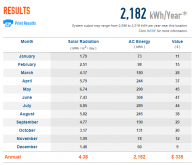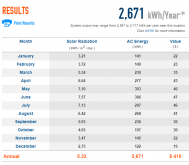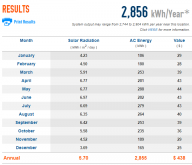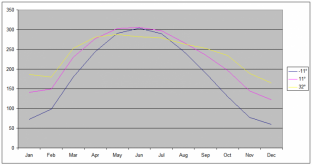Jim Burrow
Solar Enthusiast
- Joined
- Jun 27, 2020
- Messages
- 516
First please excuse me if I lose you as everyone knows how bad engineers can screw up a document written by them. Next, note that I added a pdf below in case the article is too long to read in the forum.
Background – My (6) 300W Solar panels are to be mounted on top of my covered carport roof. - mounting on top of the house roof is out of the question.
The panels will lay halfway down the roof with the lengths facing toward the house and with a distributed weight of 240 lbs. over a 90 sq. ft. area. The panel labeled (A) and is “colored blue” in the image, is slanted down -11 degrees from Horizontal and the panel labeled (B) and “colored red” in the image is slanted up by 11 degrees from the horizontal line. – Note: the panels in the image are the theoretical locations and to be determined for the best angle.
Testing – The goal for the next two weeks (beginning 1 Oct 2020), is to measure how many Lumens and the percentage of lumens will reach the solar panels to produce maximum energy with respect to the sun location in the sky and its output lumens of 16,384 as measured with my meter. I would start my measurements at 8 am first light on the panels and until 5 pm, where the sun is looking right on the side edge of the panels as seen in the image. I did this all day, every hour for 2 weeks.
Measurements - I would measure the Sun declination and Azimuth and the lumens of the sun and lumens shining on the panels for three different theoretical angles of the panels every hour with respect to the horizontal line. Note the actual panels were not used nor mounted on the carport roof as of this testing. - That is why I say theoretical. I built a tool to do all the measurements with respect to the 3 different panel angles.
Analysis – The testing went for two weeks and to my surprise, when the sun was the highest point in the sky, between noon and 1:00 pm and an angle of 40 degrees, and pointing directly at the surface of the panes, the panel that was slanted down -11 degrees, was only getting 35% of the total sun lumens of 16384. – what a bummer!
But rising my theoretical panels up 22 degrees (+11 degrees about the horizontal line/plan) the panels received 100% of the suns lumens from 10:00 AM to 3:00 PM and by 4:00 PM, the lumens were down to 27% of the suns total lumens of 16384 all day long.
It looks like I will not be able to lay the panels flat on the top of the carport roof. To get the maximum 100% sun lumens from 10:00 AM to 3:00 PM, I will need to angle my panels at point (A) up by 22 degrees or 11 degrees above the horizontal line. – final position of the panel (B).
With respect to the Sun, the highest point in the sky was only 40 degrees above the horizontal line between noon and 1:00 PM here in the San Francisco bay area at the beginning of October 2020.
With respect to the house, all “but”, the Microwave receptacle, clothes washer, and dryer plus the Air Conditioner will be powered by the Solar/Utility/Gas Generator/ battery combination controlled by my MPP 2424LV-MDS. The items not powered by Solar will stay on Utility 100% of the time by dividing my sub-panel circuit breaker box into two isolated halves. One half will always be connected to the Utility company and the other half will be connected to the 2424lv controller 120vac output port by adding a white common return wire to the left side of the box.
By using a separate utility/gas/2424LV power distribution box that I built, ties everything together via 3 100-amp DBDT switches to provide power to the left side of the breaker box. In case the 2424LV controller goes out, I can still power the whole house on utility company or by a Gas Generator by repositioning the 3 switches.
The house power during the afternoon typically uses 400w to 600w and in the mornings around 350 watts and after I go to bed, the power drops down to around 150 watts until I get back up the next morning.
So, I got my work cut out for me in making mounting brackets for my solar panels to have an elevation of 11 degrees about horizontal. I also need to add louvers to the mounting brackets to direct the wind-down as not to try and left the panels up during high winds. – Although high winds in my area never get above 25 mph and on average less than 10 mph.
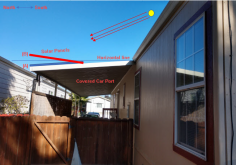
Background – My (6) 300W Solar panels are to be mounted on top of my covered carport roof. - mounting on top of the house roof is out of the question.
The panels will lay halfway down the roof with the lengths facing toward the house and with a distributed weight of 240 lbs. over a 90 sq. ft. area. The panel labeled (A) and is “colored blue” in the image, is slanted down -11 degrees from Horizontal and the panel labeled (B) and “colored red” in the image is slanted up by 11 degrees from the horizontal line. – Note: the panels in the image are the theoretical locations and to be determined for the best angle.
Testing – The goal for the next two weeks (beginning 1 Oct 2020), is to measure how many Lumens and the percentage of lumens will reach the solar panels to produce maximum energy with respect to the sun location in the sky and its output lumens of 16,384 as measured with my meter. I would start my measurements at 8 am first light on the panels and until 5 pm, where the sun is looking right on the side edge of the panels as seen in the image. I did this all day, every hour for 2 weeks.
Measurements - I would measure the Sun declination and Azimuth and the lumens of the sun and lumens shining on the panels for three different theoretical angles of the panels every hour with respect to the horizontal line. Note the actual panels were not used nor mounted on the carport roof as of this testing. - That is why I say theoretical. I built a tool to do all the measurements with respect to the 3 different panel angles.
Analysis – The testing went for two weeks and to my surprise, when the sun was the highest point in the sky, between noon and 1:00 pm and an angle of 40 degrees, and pointing directly at the surface of the panes, the panel that was slanted down -11 degrees, was only getting 35% of the total sun lumens of 16384. – what a bummer!
But rising my theoretical panels up 22 degrees (+11 degrees about the horizontal line/plan) the panels received 100% of the suns lumens from 10:00 AM to 3:00 PM and by 4:00 PM, the lumens were down to 27% of the suns total lumens of 16384 all day long.
It looks like I will not be able to lay the panels flat on the top of the carport roof. To get the maximum 100% sun lumens from 10:00 AM to 3:00 PM, I will need to angle my panels at point (A) up by 22 degrees or 11 degrees above the horizontal line. – final position of the panel (B).
With respect to the Sun, the highest point in the sky was only 40 degrees above the horizontal line between noon and 1:00 PM here in the San Francisco bay area at the beginning of October 2020.
With respect to the house, all “but”, the Microwave receptacle, clothes washer, and dryer plus the Air Conditioner will be powered by the Solar/Utility/Gas Generator/ battery combination controlled by my MPP 2424LV-MDS. The items not powered by Solar will stay on Utility 100% of the time by dividing my sub-panel circuit breaker box into two isolated halves. One half will always be connected to the Utility company and the other half will be connected to the 2424lv controller 120vac output port by adding a white common return wire to the left side of the box.
By using a separate utility/gas/2424LV power distribution box that I built, ties everything together via 3 100-amp DBDT switches to provide power to the left side of the breaker box. In case the 2424LV controller goes out, I can still power the whole house on utility company or by a Gas Generator by repositioning the 3 switches.
The house power during the afternoon typically uses 400w to 600w and in the mornings around 350 watts and after I go to bed, the power drops down to around 150 watts until I get back up the next morning.
So, I got my work cut out for me in making mounting brackets for my solar panels to have an elevation of 11 degrees about horizontal. I also need to add louvers to the mounting brackets to direct the wind-down as not to try and left the panels up during high winds. – Although high winds in my area never get above 25 mph and on average less than 10 mph.




